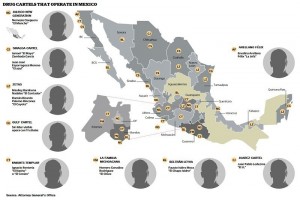The balcanization of Mexican cartels

This map of drug trafficking in Mexico is based on reports from the Attorney General's Office, the U.S. Department of Justice and the Treasury, as well as interviews with experts. (Photo: EL UNIVERSAL. )
With the capture or killing of the main drug lords in recent years,
Mexican drug cartels fragmented into cells that seem to have the same influence
as their predecessors.
This map of drug trafficking in Mexico is based on reports from the
Attorney General's Office, the U.S. Department of Justice and the Treasury, as
well as interviews with experts.
After the arrest of Joaquín "El Chapo" Guzmán, leader of the
Sinaloa Cartel; Servando Gómez "La Tuta", head of the Knights Templar
cartel; Vicente Carrillo Fuentes (El Viceroy), leader of the Juárez Cartel;
Miguel and Omar Treviño Morales, heads of the Zetas cartel; and the killing of
Nazario Moreno "El Chayo", who commanded La Familia Michoacana,
Ignacio Coronel and Arturo Beltrán Leyva (El Barbas), territorial fighting
worsened. Also, new leaders emerged, though they are mostly regional and use
armed cells defend "their" territory.
According to the latest report from the Attorney General's Office (PGR)
nine cartels operate in Mexico: Sinaloa, Jalisco New Generation, Los Zetas,
Gulf, Tijuana, Beltrán Leyva, Juárez, Familia Michoacana and Knights Templar.
Also, there are 45 criminal cells that apart from selling drugs steal
hydrocarbons, kidnap and extort people and profit with human trafficking.
Unlike their predecessors, the new generation of drug lords display
their power on social networks, where they also threaten rivals, publicize
executions and show off their luxurious life style. They also infiltrate police
forces and forge alliances with politicians and businessmen.
Arellano Félix
According to the Drug Enforcement Administration (DEA) the Arellano
Félix cartel controlled the states of Sinaloa, Sonora, Jalisco and Nuevo León
for over 20 years.
After the capture of Fernando Sánchez Arellano, it became the first
cartel to have a woman as its leader: Enedina Arellano Félix, also known as
"La Jefa". Currently it operates in Baja California as the Tijuana
Cartel and has three cells.
The first one, "El Chan", is headed by Juan Lorenzo Vargas
Gallardo, a former ministerial agent who was arrested in October 2013 and
released last August. The second cell is known as "El Jorquera" and
is commanded by the Jorquera family and the third cell is known as "El
Kieto".
La Familia Michoacana
Despite the capture of its leaders -Nazario Moreno, Jesús Méndez Vargas,
Servando Gómez Martínez, Enrique Kike Plancarte and Dionisio Loya Plancarte- it
continues to operate in Morelos and Guerrero. Homero González Rodríguez, also
known as "El Chivo", has been identified as one of its current
leaders.
Knights Templar
It emerged after the dispute between of Nazario Moreno (El Chayo) and
Servando Gómez Martínez (La Tuta). After the arrest of La Tuta, Ignacio
Rentería El Nacho (El Cenizo) has been identified as the new leader of the
cartel.
Los Zetas
Apart from selling cocaine and marijuana, this criminal organization
steals fuels, extorts and kidnaps people and profits from human trafficking and
piracy.
Three lieutenants of Miguel and Omar Treviño Morales have been
identified as the heads of the cartel: Maxiley Barahona Nadales (El Contador),
Román Ricardo Palomo (El Coyote) and Eduardo Almanza Morales.
According to the U.S. Department of Justice it operates in Quintana Roo,
Tabasco, Veracruz, Coahuila, Tamaulipas, San Luis Potosí and Guanajuato.
Gulf Cartel
With the death of Ezequiel Cárdenas Guillén in November 2010, the Gulf
Cartel stopped operating in Coahuila, Chihuahua, Tabasco, Veracruz, San Luis
Potosí, Guerrero and Nuevo León.
Currently it operates in
Tamaulipas and Quintana Roo through eleven criminal cells: Ciclones, Los
Pantera, Los Sierra, Los Fresitas, Grupo de Apoyo Ceros or M3, Grupo Pumas,
Grupo Bravo, Grupo Dragones, Grupo Lacoste, Los Rojos and Los Metros.
Los Metros does not have a
leader after José Hugo Rodríguez Sánchez (El Gafe) was arrested in April, while
Los Rojos is commanded by Juan Mejía González (El R-1).
Grupo Lacoste is headed by Ignacio Zúñiga Blanco (El Barny), while Grupo
Dragones is headed by Juan Martín Zárate Chávez.
In the United States the Gulf Cartel operates through alliances with
local gangs.
Beltrán Leyva Cartel
After Arturo Beltrán Leyva (El Barbas) was killed in December 2009, the
cartel fragmented but his family kept controlling it for five more years.
After the arrest of Héctor Beltrán Leyva (El H) in October 2014, seven
violent cells emerged: Los Mazaltecos, El 2 mil, Los Granados, Los Rojos, La
Oficina, Los Ardillos and the Independent Cartel of Acapulco (CIDA).
Fausto Isidro Meza Flores, leader of Los Mazaltecos, operates in Sinaloa
and Baja California Sur while Salvador Granados Vargas (Chava Grandos) operates
in the region known as "Tierra Caliente" in Guerrero.
Los Rojos control certain regions of the north and center of Guerrero,
but it has more influence in Morelos under the leadership of Santiago Mazari
Hernández (El Carrete).
Los Ardillos, that operates in the mountainous region and the center of
the state, was founded by Celso Ortega Rosas (La Ardilla), who was killed in
January 2011.
The Independent Cartel of Acapulco was disbanded after the arrest of
Víctor Aguirre Garzón (El Gordo) last March. Now the area is controlled by
"La Mochomera", commanded by the son of Alfredo Beltrán Leyva known
as "El Dos Letras".
The most powerful cell is Guerreros Unidos, that operates in Guerrero,
Morelos and the State of Mexico and even in the United States. The criminal
group is allegedly involved in the disappearance of the 43 teachers in training
of Ayotzinapa. It is commanded by "El Chucky", who remains at large.
Jalisco New Generation Cartel
It is considered one of the most dangerous criminal organizations by the
governments of Mexico and the United States.
It stem from the Cartel del Milenio founded by José and Luis Valencia in
Michoacán, but has since expanded its influence to Jalisco.
With the death of Ignacio Nacho Coronel in 2010, the Cartel del Milenio
got divided in two cells: La Resistencia y Los Torcidos. The latter became the
Jalisco New Generation Cartel (CJNG), that sells synthetic drugs, marijuana and
cocaine and also profits with extortion, human trafficking and money
laundering.
With its cell Los Cuinis, it controls clandestine laboratories of
synthetic drugs in Jalisco y Colima. It also operates in Nayarit, Guanajuato,
State of Mexico and Mexico City, according to the Drug Administration
Enforcement (DEA) and the PGR.
Its leader is Nemesio Oseguera Cervantes (El Mencho), blacklisted by the
U.S. Treasury Department along with his brother in law and leader of Los
Cuinis, Abigael González Valencia, who was arrested in February.
Sinaloa Cartel
Through strategic alliances with international criminal organizations,
it sells cocaine, heroine, marijuana, synthetic drugs, piracy and smuggled
goods in South America, United States, Canda, Europe, Africa, Asia and the
Middle East.
It also launders money in Argentina, Ecuador, Peru, Panama, Costa Rica
and Guatemala, where it partners with local gangs.
The arrest of its leader, Joaquín "El Chapo" Guzmán in
February 2014 did not affect its operation.
Currently it has three leaders: Ismael "El Mayo" Zambada
García, Juan José Esparragoza Moreno (El Azul) and Dámaso López Nuñez (El
Licenciado), considered the cartel's main lieutenant.
It fights with rival cartels to control Tamaulipas, Coahuila, Nayarit,
Jalisco, Colima and Michoacán.
The balcanization of big cartels
About the "balcanization" of big cartels, Gerardo Rodríguez,
an expert on national security and terrorism, said that criminal cells have a
better control over the territories because they know economic flows firsthand
and can create local protection networks more easily.
"Mexico is copying the model of the emerging criminal gangs of
Colombia, where small groups diversified into other profitable crimes such as
extortion, theft, human trafficking and kidnapping," said the member of
Colectivo de Análisis de la Seguridad con Democracia (Casede).
He added that the government's strategy to fight organized crime is
good. However, he warned that it may fail if the structures that are part of
the pyramid are not destroyed.
"After capturing the big drug lords they have to do the same with
the other leaders and go after their financial assets".
Javier Oliva, an expert on national security and professor at the
National Autonomous University of Mexico, believes that "fragmentation was
very predictable, because experience had shown that when drug lords are
captured, cartels tend to divide, which leads to clashes
over the control of territories."






